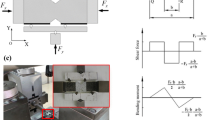Abstract
The deformation and fracture of a 4D-reinforced carbon–carbon composite material are studied during tension, compression, and three-point bending. A deformation and fracture mechanism is proposed for such a material during its compression and tension. The minimum reinforcing bar length in a carbon matrix, which provides effective external load resistance of the material, is determined.





Similar content being viewed by others
REFERENCES
S. Sarcar, V. G. Sekharan, and R. Mitra, “4D carbon–carbon composite processing and its properties in comparison with other carbon–carbon preforms,” Tr. Indian Ceram. Soc. 66 (3), 141–145 (2007).
A. A. Antanovich and S. A. Kolesnikov, “Isostatic technologies in the manufacture of carbon structural materials,” in Advanced Materials and Technologies (UO VGTU, Vitebsk, 2017), Vol. 1.
Wu Xiao-jun, Qiao Sheng-ru, Cheng Wen, Zou Wu, Cui Hong, and Wang Kun-jie, “Tensile properties of 4D braided carbon/carbon composites produced from carbon fiber bundles and carbon rods,” New Carbon Materials 28 (4), 300–306 (2013).
I. A. Pen’kov, A. K. Protsenko, G. V. Malyutin, and B. G. Klevitskii, “Multidimensional reinforced carbon–carbon composite materials. Improving the technology of their production on the basis of gasostatic equipment,” in Proceedings of VIII International Conference on Carbon: Fundamental Problems of Science, Materials Science, Technology (Troitsk, 2012), pp. 352–353.
A. I. Sokolov, A. K. Protsenko, and S. A. Kolesnikov, “Multidimensional reinforced carbon–carbon composite materials,” Novye Prom. Tekhn., No. 3, 29–32 (2009).
Wajed Zaman, Ke-zhi Li, Wei Li, Hira Zaman, and Khurshid Ali, “Flexural strength and thermal expansion of 4D carbon/carbon composites after flexural fatigue loading,” New Carbon Materials 29 (3), 169–175 (2014).
Shi Hong-bin, Tang Min, Gao Bo, and Su Jun-ming, “Effect of graphitization parameters on the residual stress in 4D carbon fiber/carbon composites,” New Carbon Materials 26 (4), 287–292 (2011).
Sh. Farhan, N. Ul-Haq, and W.-S. Kuo, “Degradation behavior of 4D carbon/carbon composites under supersonic oxidative air plasma,” Ceram. Int. 39, 7135–7142 (2013).
A. L. Medvedskii, Yu. V. Kornev, and A. S. Kurbatov, “Investigation of the physical and mechanical properties of 4D carbon–carbon composite material at macro and micro levels under the action of high temperatures,” Trudy MAI. Aerokosm. Dvigatelestr., No. 41, 7 (2010).
A. K. Protsenko and S. A. Kolesnikov, “Development of carbon–carbon technologies and prospects for their development,” in Nauchn.-Issl. Inst. Konstr. Mater. na Osnove Grafita—55 Let (Nauchn. Tekhn., Moscow, 2015).
A. A. Antanovich and S. A. Kolesnikov, “Density and strength of carbon–carbon structural materials in the isostatic technology of forming carbon matrices,” in Proceedings of 60th International Conference on Challenging Problems of Strength UO VGTU, Vitebsk, 2018), pp. 42–45.
S. A. Kolesnikov and D. S. Maksimova, “Formation of physical and mechanical characteristics of carbon–carbon materials with isostatic technology for forming a carbon matrix,” Izv. Vyssh. Uchebn. Zaved., Khim. Khim. Tekhnol. 61 (11), 67–80 (2018).
G. M. Gunyaev, Structure and Properties of Polymer Fiber Composites (Khimiya, Moscow, 1981).
E. S. Prusov, “Computer tomography for the problems of three-dimensional materials science,” Fundam. Issled., No. 5 (2), 318–323 (2015).
A. A. Antanovich and S. A. Kolesnikov, “Calculated estimates of the strength level and the thermal strength indicators of carbon–carbon composite materials in the isostatic technology for forming carbon matrices,” Izv. Ross. Akad. Nauk, Ser. Fiz. 83 (10), 1131–1135 (2019).
Author information
Authors and Affiliations
Corresponding author
Additional information
Translated by K. Shakhlevich
Rights and permissions
About this article
Cite this article
Antanovich, A.A., Kolesnikov, S.A. & Maksimova, D.S. Some Features of the Deformation and Fracture of a 4D-Reinforced Carbon–Carbon Composite Material. Russ. Metall. 2021, 377–380 (2021). https://doi.org/10.1134/S0036029521040029
Received:
Revised:
Accepted:
Published:
Issue Date:
DOI: https://doi.org/10.1134/S0036029521040029




